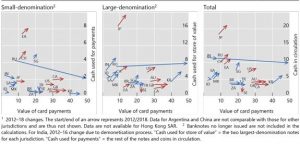Despite the rapid rise of digital payments, cash isn’t on its way out yet.
That’s the key message from the Bank for International Settlements (BIS), which published its annual ‘Red Book’ statistics on payments and financial market infrastructures earlier this week.
The BIS hosts the Committee on Payments and Market Infrastructures (CPMI), one of the major policymaking bodies for the world’s financial system.
But while cash is still king, says the BIS, its role is morphing. And it’s changing in a way that poses a dilemma for governments and central banks.
There may be two reasons—both uncomfortable for governments—for the hoarding of high-value cash
In its latest Red Book, the BIS cites data showing that, with a few exceptions, such as Switzerland, the EU and Singapore, the use of small-denomination notes and coins is falling around the world.
Instead of carrying around lots of small change, customers are switching to more convenient mobile and card-based payment methods.
But while customer demand for low-value cash is dropping, there is growing demand for high-denomination notes, says the BIS, with pronounced rises in Japan, Switzerland and the US.
There may be two reasons—both uncomfortable for governments—for the hoarding of high-value cash: negative rates and illicit activity.
Japan and Switzerland have pursued negative official interest rate policies for years, incentivising savers to hold banknotes rather than cash in bank accounts, where they face a steady erosion of their capital.
These opposing forces appear to set up a clash.
Earlier this year the IMF suggested that governments wishing to impose negative interest rates on their domestic economies could counteract the population’s desire to hoard cash.
Instead of just issuing cash to the general public, the IMF said, central banks could also issue e-money.
The central bank could then set a negative rate on the e-money, said the IMF, causing its capital value to fall over time.
“At the same time, shops would start advertising prices in e-money and cash separately, just as shops in some small open economies already advertise prices both in domestic and in bordering foreign currencies.”
“Cash would thereby be losing value both in terms of goods and in terms of e-money, and there would be no benefit to holding cash relative to bank deposits,” the IMF said.
Meanwhile, the number of US $100 bills in circulation has more than quadrupled in the last two decades.
The US central bank says growing overseas demand for its currency could reflect geopolitical instability. Others say the growth in usage of the $100 bill may signal its widespread use in global money laundering activity.
Change in payments behaviour among CPMI countries from 2012 to 2018

Source: BIS
The rising consumer appetite for high-value notes also flies in the face of recent policy actions by several governments around the world.
Earlier this year, 19 European central banks stopped the production of 500 euro banknotes. The European Central Bank earlier cited concerns about illicit activity as the reason for withdrawing the bills from circulation.
In 2016 India withdrew its two highest-denomination notes overnight, causing social unrest. India’s government later admitted that the move had also dampened growth.
“Innovation is making domestic payments increasingly convenient, instantaneous and ubiquitous”
While the battle over the use of cash between governments and citizens appears to be intensifying, there’s no stopping the rise of electronic payments.
Historically, the transfer of money from the bank account of a payer to that of the recipient could take days. The US, the world’s largest economy, is still struggling to speed up its payments.
But other countries are moving ahead. Fast retail payments systems, where the transfer of money takes place in near real-time, now exist in 45 jurisdictions, says the BIS.
“Innovation is making domestic payments increasingly convenient, instantaneous and ubiquitous,” it says.
And the evidence is that consumers also crave convenience in paying, the BIS says.
This is reflected in the number of contactless cards per inhabitant rising rapidly in both advanced and emerging market economies.
The value of card payments relative to GDP is increasing for all but a few CPMI jurisdictions, says the BIS, and is approaching 50 percent of GDP in some countries.
And consumers are increasingly using debit or credit cards when abroad, the BIS says. Cross-border card payments have grown twice as fast as domestic payments since 2012, it reports.
Don’t miss any more New Money Review content: sign up here for our newsletter









